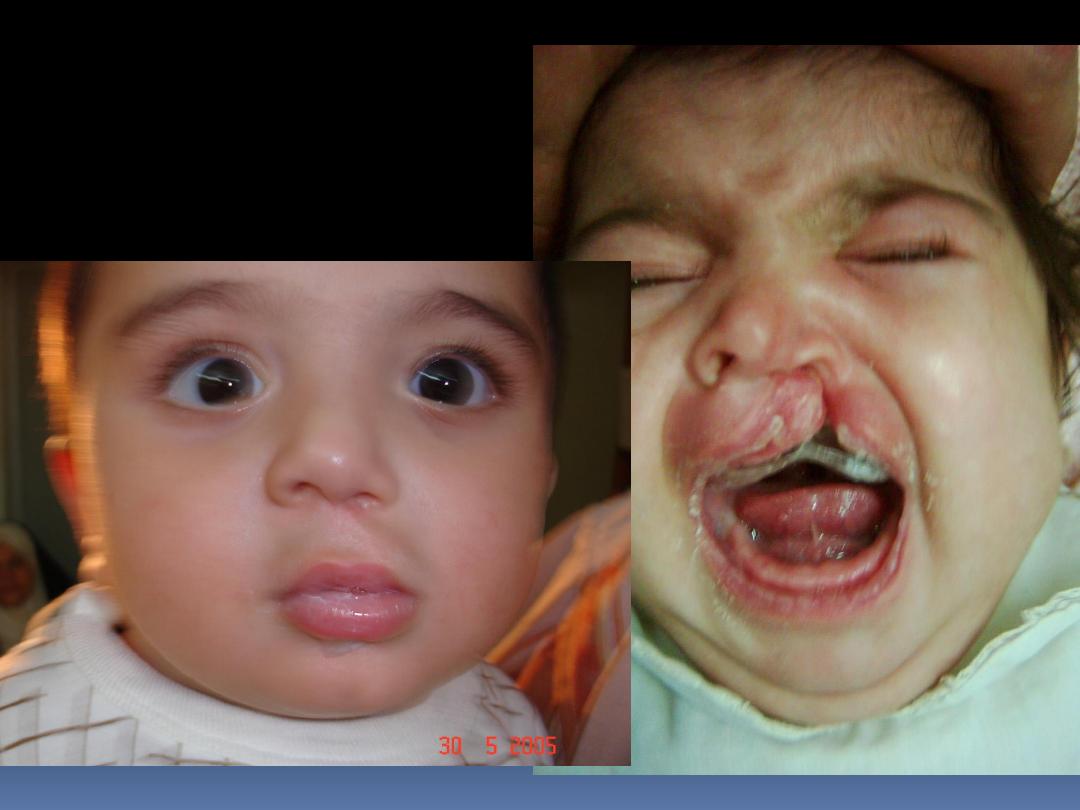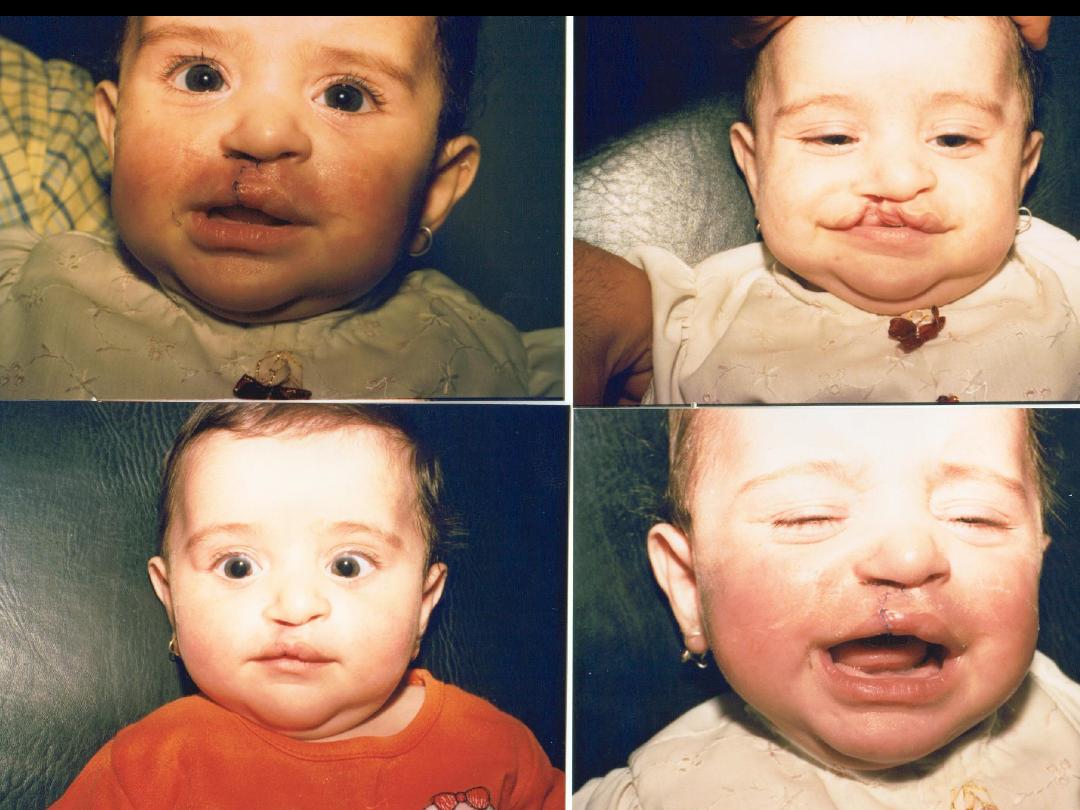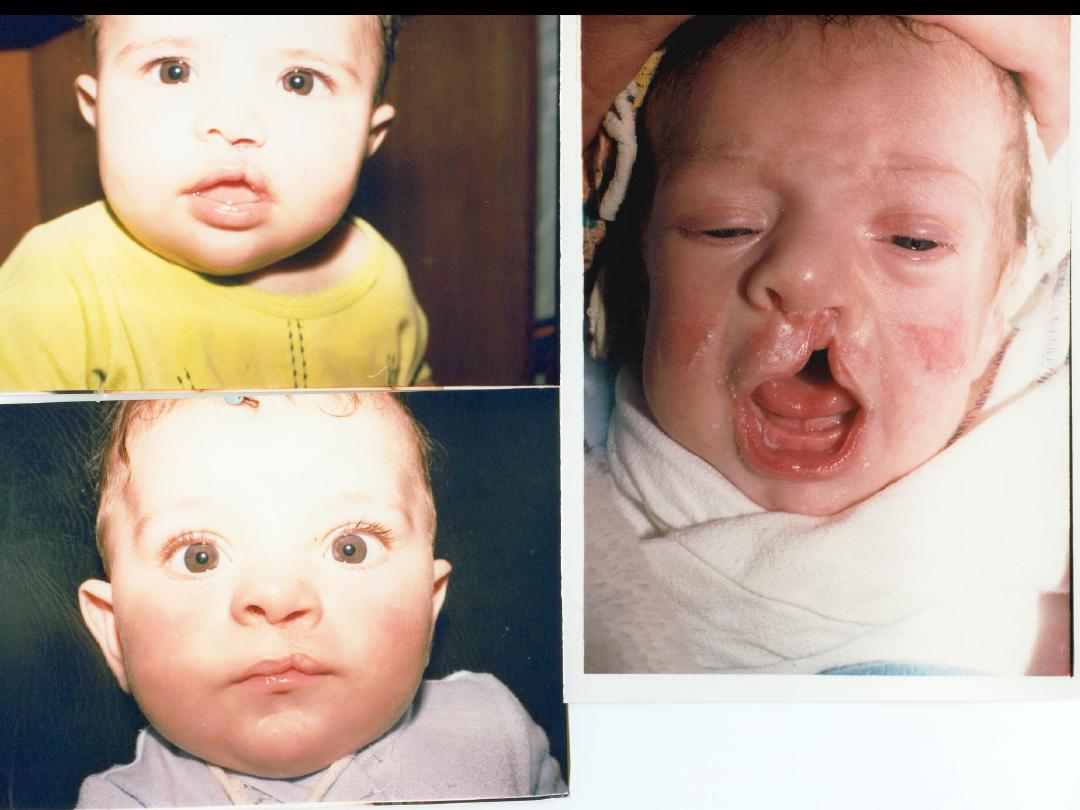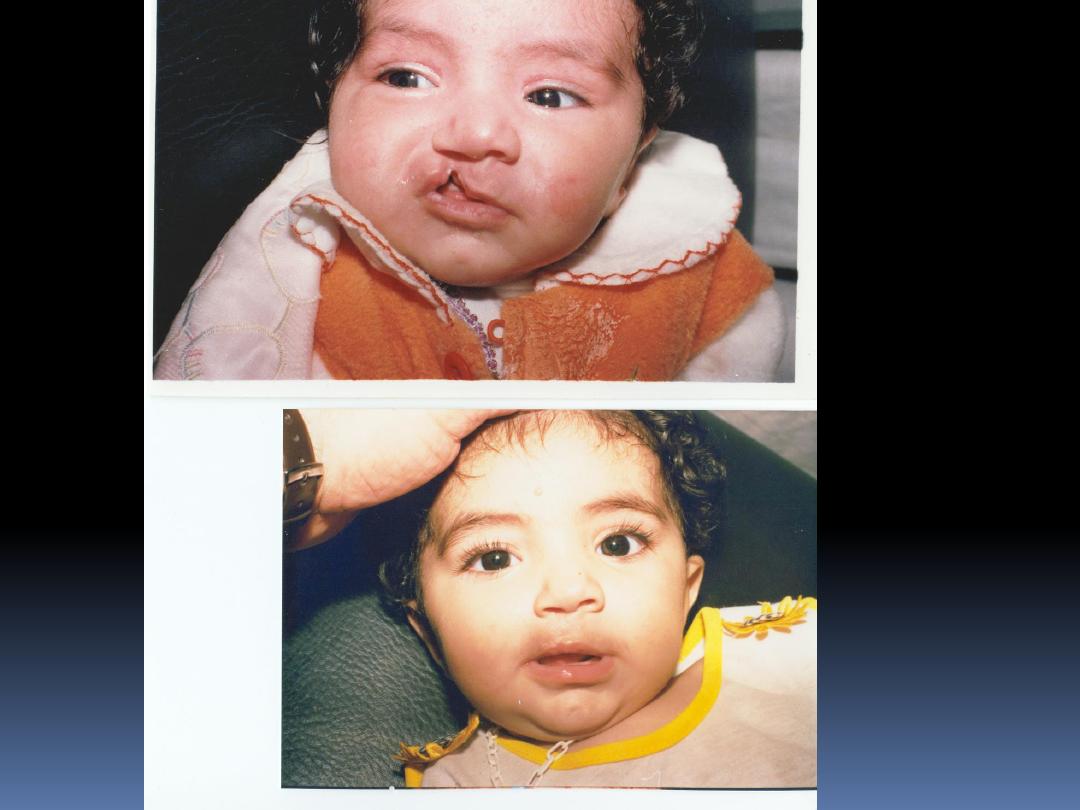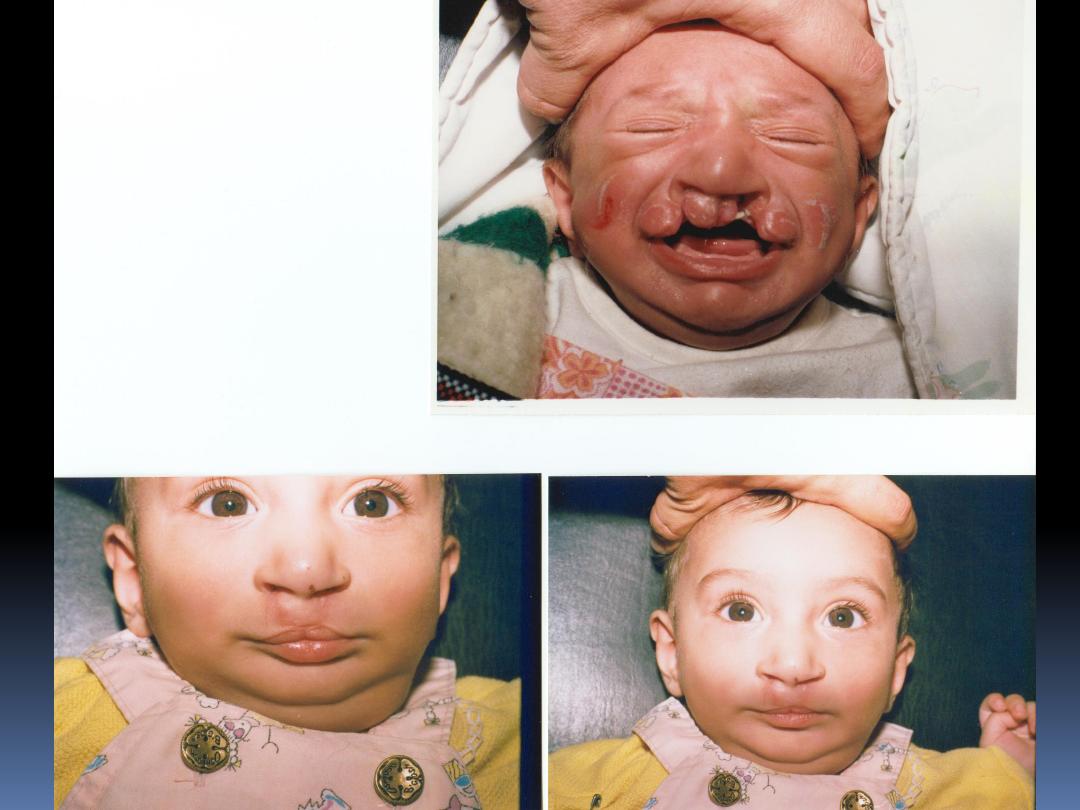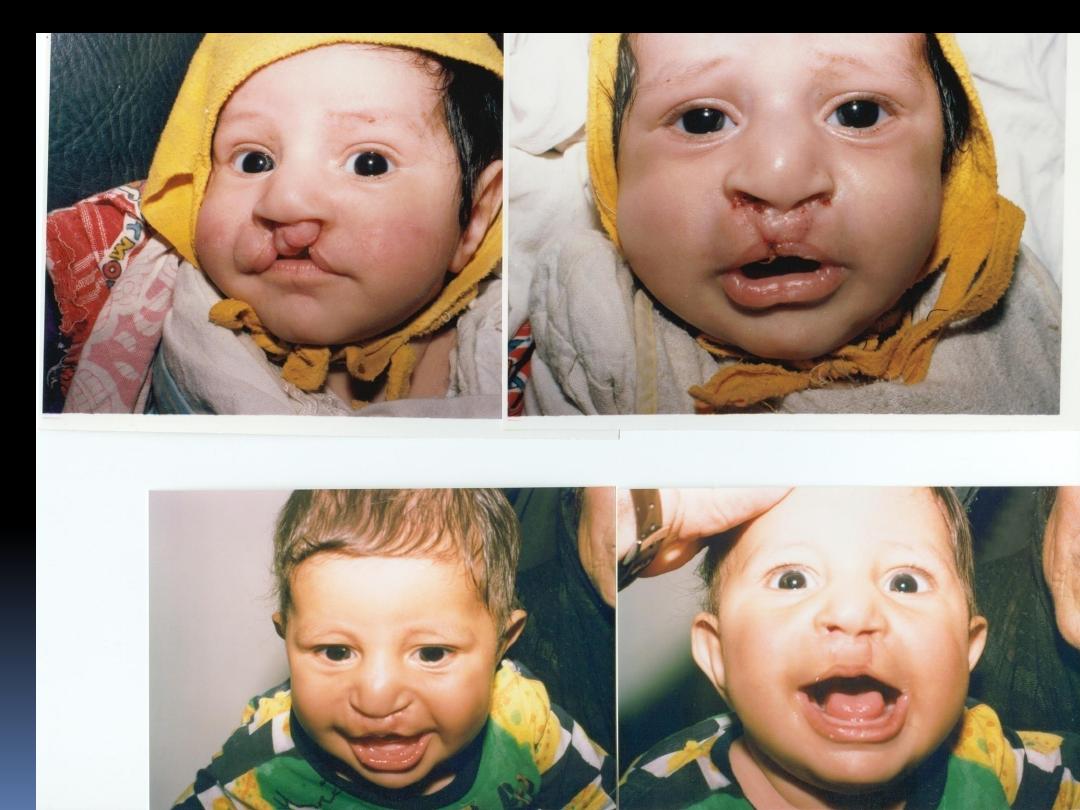
CLEFT LIP AND PALATE
Dr.ALI AL BAZZAZ
PLASTIC SURGON

Cleft lip (cheiloschisis) and cleft
palate (palatoschisis
),
which can also occur together as cleft lip and
palate, are variations of a type of
clefting
caused by abnormal
. A cleft is a
fissure or opening
—a gap. It is the non-fusion of
the body's natural structures that form before
birth. Approximately 1 in 700 children born have a
cleft lip or a cleft palate or both. In decades past,
the condition was sometimes referred to
as harelip, based on the similarity to the cleft in
the lip of a
, but that term is now generally
considered to be offensive.

During the first six to eight weeks of
pregnancy, the shape of the embryo's head is
formed. Five primitive tissue lobes grow:
a) one from the top of the head down towards the
future upper lip; (Frontonasal Prominence)
b-c) two from the cheeks, which meet the first
lobe to form the upper lip; (Maxillar Prominence)
d-e) and just below, two additional lobes grow
from each side, which form the chin and lower lip;
(Mandibular Prominence)

If these tissues fail to meet, a gap
appears where the tissues should
have joined (fused). This may
happen in any single joining site, or
simultaneously in several or all of
them. The resulting birth defect
reflects the locations and severity of
individual fusion failures (e.g., from
a small lip or palate fissure up to a
completely malformed face).

.
Formation of the palate is the last step
in joining the five embryonic facial
lobes, and involves the back portions of
the lobes b and c. These back portions
are called palatal shelves, which grow
towards each other until they fuse in
the middle, This process is very
vulnerable to multiple toxic substances,
environmental pollutants, and
nutritional imbalance

CAUSES OF CLEFT LIP AND PALATE

Genetic factors:
contributing to cleft lip
and cleft palate formation have been
identified for some
cases, but
knowledge about genetic factors that
contribute to the more common isolated
cases of cleft lip/palate is still patchy.
Many clefts run in families, even though in
some cases there does not seem to be an
identifiable syndrome present ,possibly
because of the current incomplete genetic
understanding of midfacial development.

Environmental influences:
may also cause, or interact with genetics to produce, orofacial
clefting:
1. the gene
2.In humans,
have also been linked to maternal hypoxia, as
.
3.maternal
4. some forms of maternal
5. Other environmental factors that have been studied include:
maternal diet and vitamin intake; retinoids
— which are
members of the vitamin A family;
drugs; alcohol; cigarette use; nitrate compounds;
organic solvents; parental exposure to lead; and illegal drugs
(cocaine, crack cocaine, heroin, etc.).
Current research continues to investigate the extent to which
can reduce the incidence of clefting.

TYPES OF CLEFT LIP

microform cleft.
A microform cleft can appear as small as a
little dent in the red part of the lip or look like
a scar from the lip up to the nostril. In some
cases
underneath
the scar is affected and might require
reconstructive surgery. It is advised to have
newborn infants with a microform cleft
checked with a
as soon as
possible to determine the severity of the
cleft.

If the cleft does not affect the palate
structure of the mouth it is referred to as
cleft lip. Cleft lip is formed in the top of the
lip as either a small gap or an indentation
in the lip (
partial or incomplete cleft
) or it
continues into the nose (
complete cleft
).
Lip cleft can occur as a one sided
(unilateral) or two sided (bilateral). It is due
to the failure of fusion of the maxillary and
medial
(formation of the
primary palate).
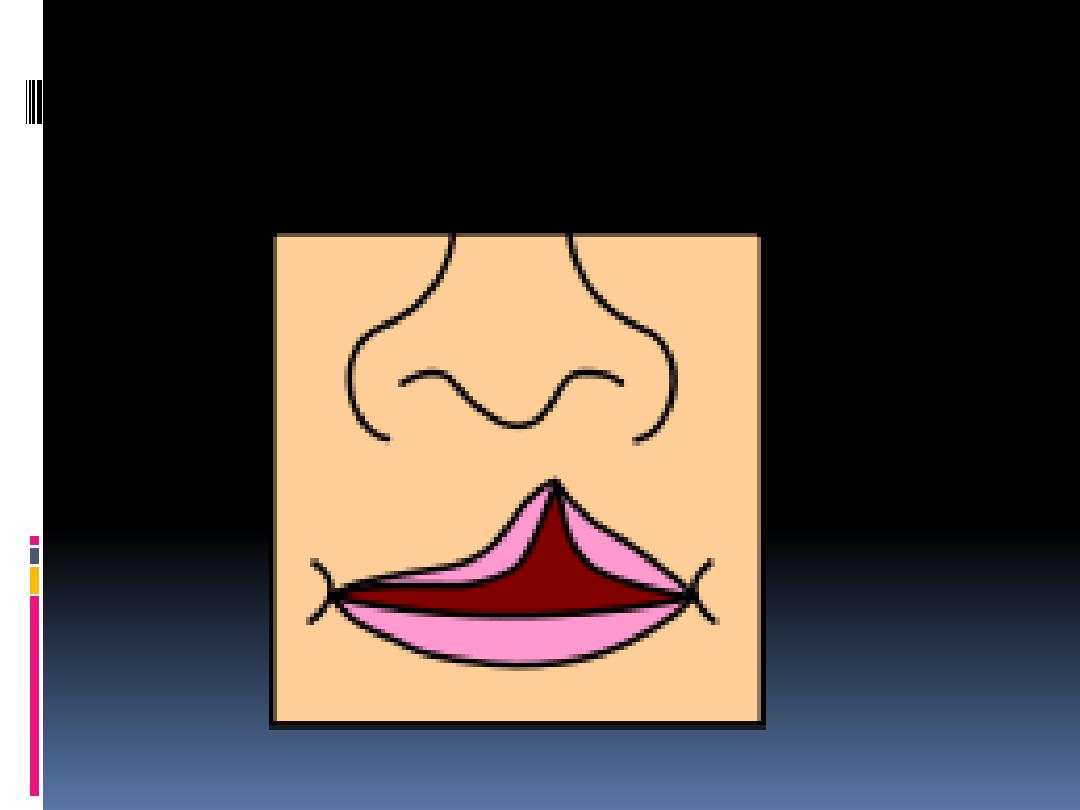
Incomplete cleft lip
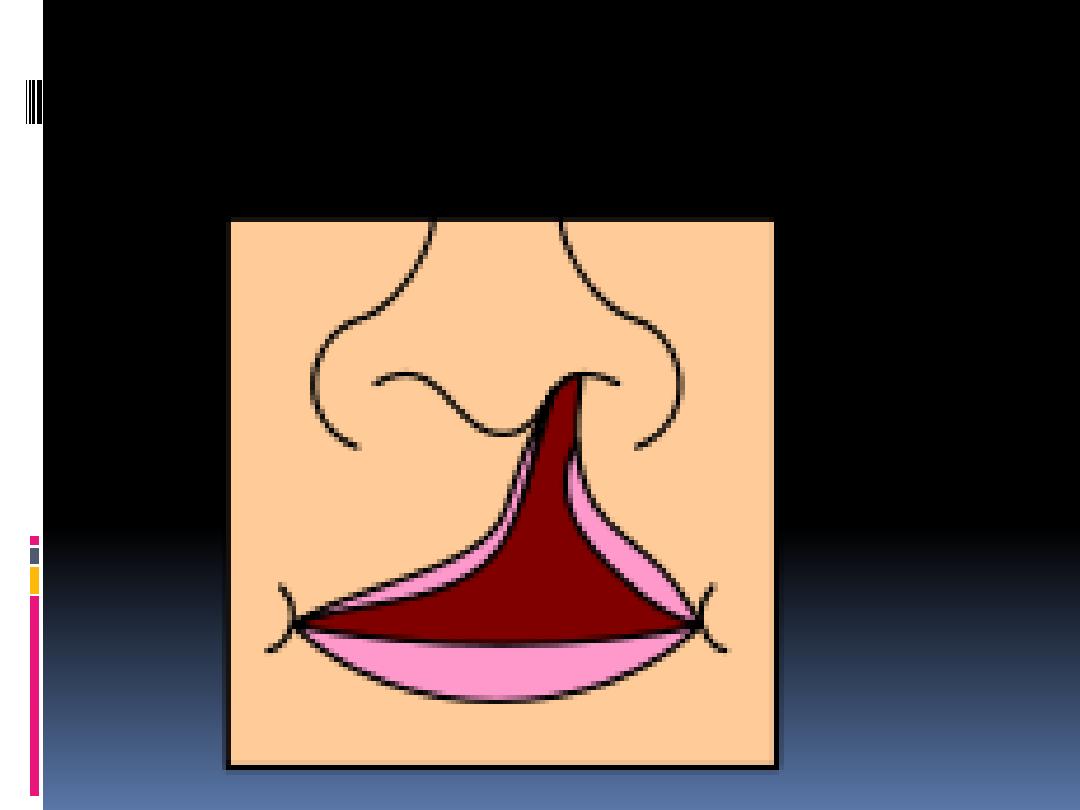
Complete cleft lip
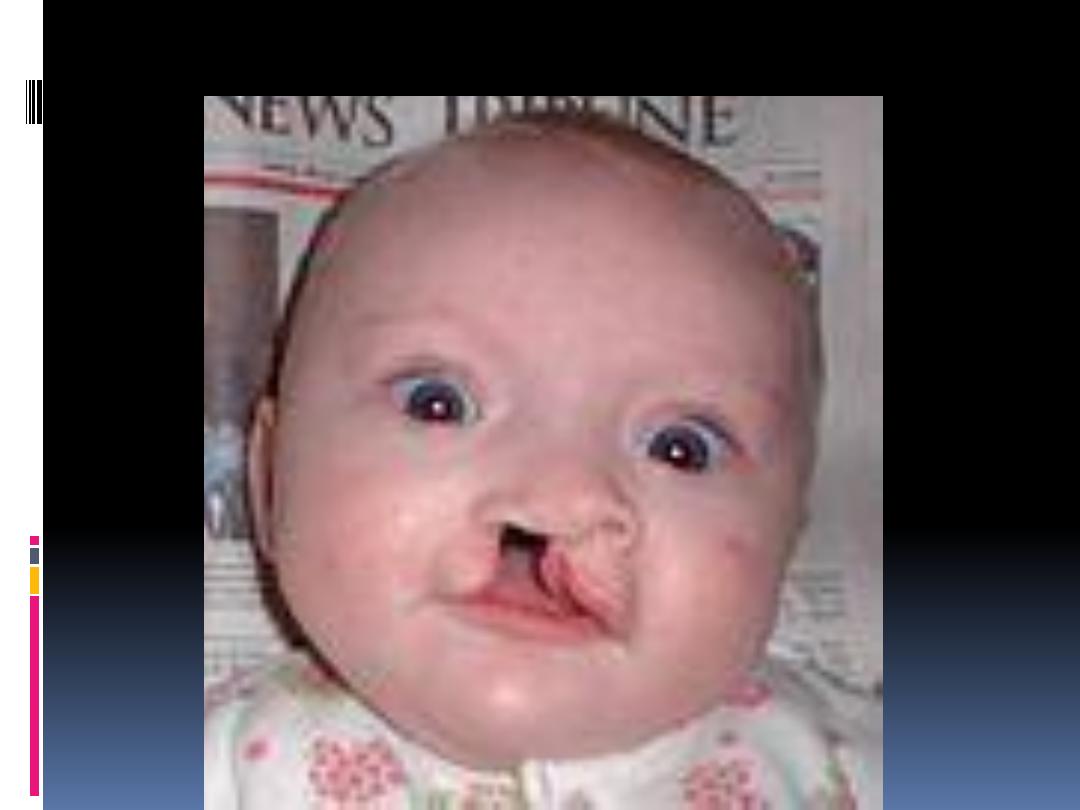
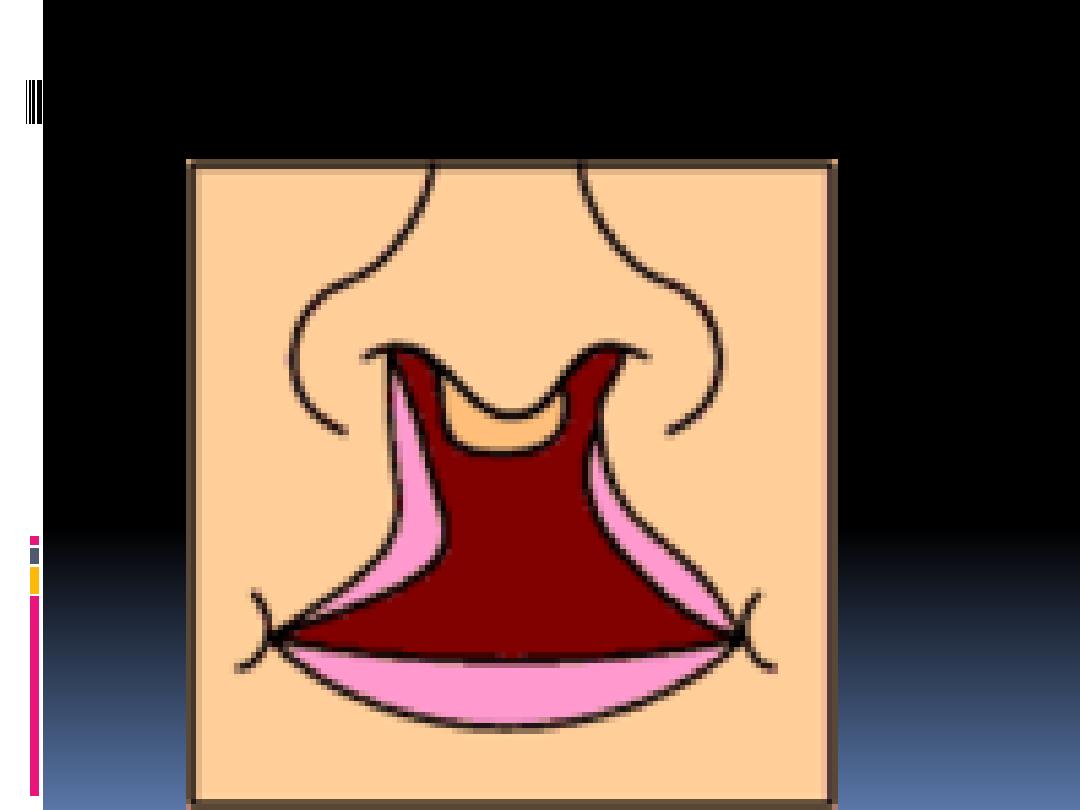
Bilateral cleft lip
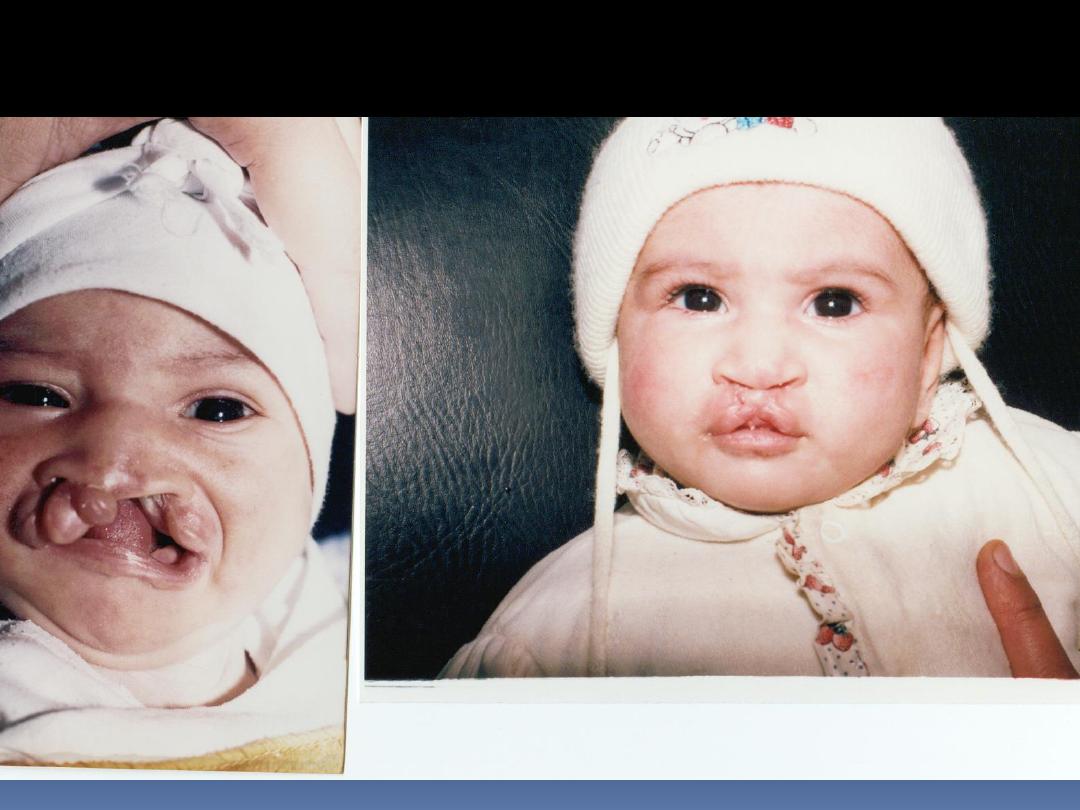

Cleft palate
is a condition in which the two plates
of the
completely joined. The
in these cases cleft as well. In most
cases, cleft lip is also present. Cleft
palate occurs in about one in 700 live
births worldwide.

Palate cleft:
can occur as complete (soft and hard
palate, possibly including a gap in the
jaw) or incomplete (a 'hole' in the roof
of the mouth, usually as a cleft soft
palate). When cleft palate occurs,
the
is usually split. It occurs due
to the failure of fusion of the lateral
palatine processes, the nasal septum,
and/or the median palatine processes
(formation of the
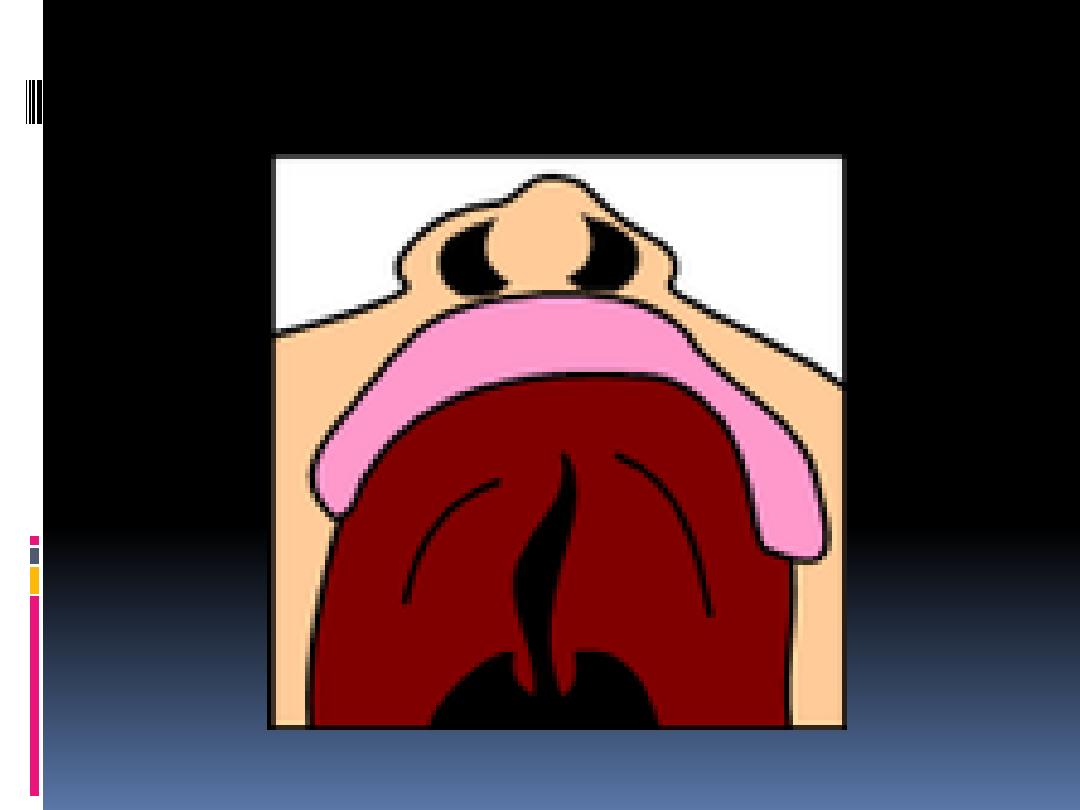
Incomplete cleft palate
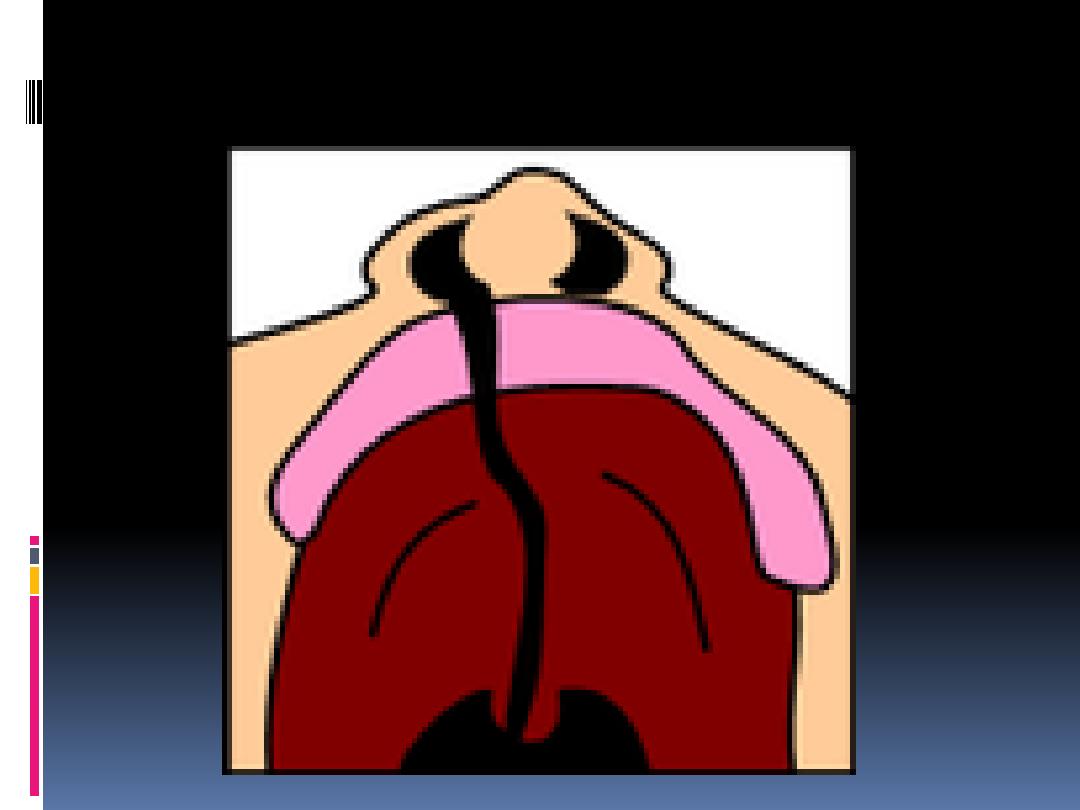
Complete unilateral cleft
palate
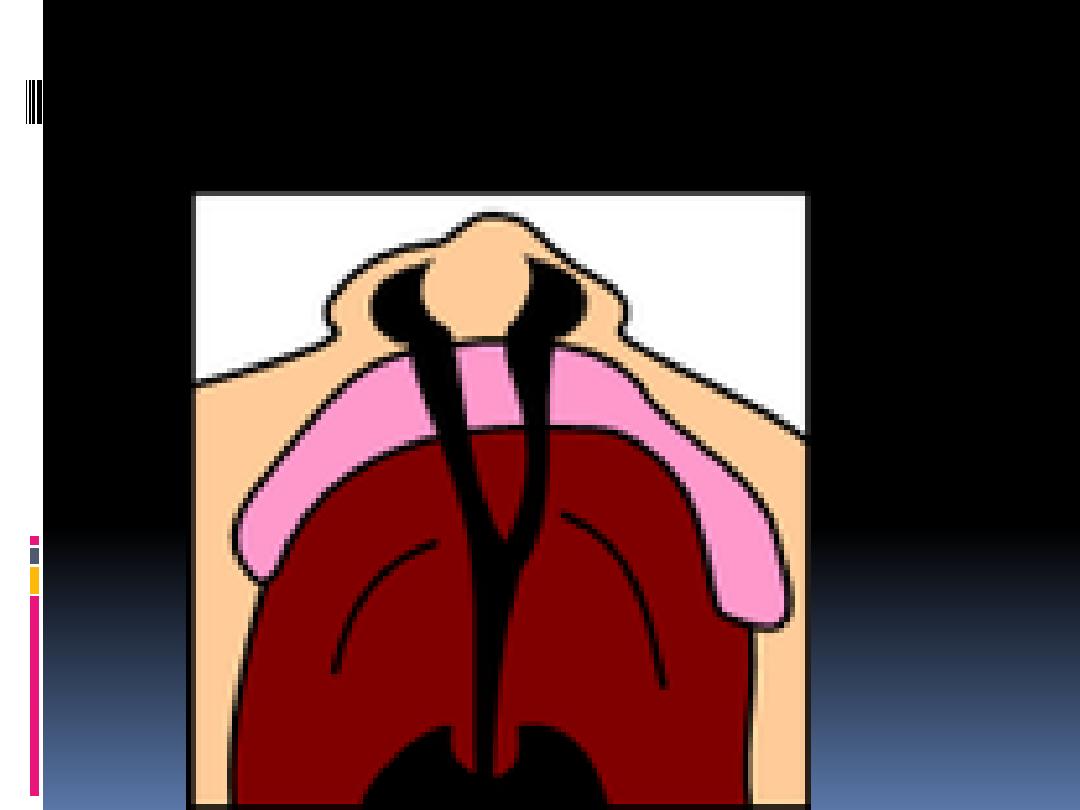
Bilateral complete cleft
palate

Submucous cleft palate (SMCP)
can also occur, which is a cleft of
the soft palate with a classic
clinical triad of a bifid, or split,
uvula which is found dangling in
the back of the throat, a furrow
along the midline of the soft
palate, and a notch in the back
margin of the hard palate.

Cleft may cause problems with:
feeding, ear disease, speech and
socialization.
Due to lack of suction, an infant with a cleft
may have trouble feeding. An infant with a
cleft palate will have greater success
feeding in a more upright position. Gravity
will help prevent milk from coming through
the baby's nose if he/she has cleft palate.
Cleft palate problems

Individuals with cleft also face many
middle ear infections which may
eventually lead to hearing loss.
The
and external
ear canals may be angled or tortuous,
leading to food or other contamination
of a part of the body that is normally
self-cleaning
Hearing and speech
problems

.
Hearing
is related to learning to speak.
Babies with palatal clefts may have
compromised hearing and therefore, if the
baby cannot hear, it cannot try to mimic the
sounds of speech. Thus, even before
expressive
language acquisition, the baby
with the cleft palate is at risk for
receptive
language acquisition. Because the lips and
palate are both used in pronunciation,
individuals with cleft usually need the aid of
a speech therapist.

Speech problems
Children with cleft palate typically have a
variety of speech problems. Some speech
problems result directly from anatomical
differences such as
inadequacy
Velopharyngeal
.
refers to the inability of the soft palate to
close the opening from the throat to the
nasal cavity, which is necessary for many
speech sounds, such as /p/, /b/, /t/, /d/, /s/,
This type of errors typically
/z/, etc.
resolve after palate repair

Cleft lip repair:
Within the first 2
performed to close the cleft lip. While surgery to repair
a cleft lip can be performed soon after birth, often the
preferred age by
. Millard performed the
(MASH) unit in Korea.
Often an incomplete cleft lip requires the same surgery
as complete cleft., following the "rule of 10
s― (the child
is at least 10 weeks of age; weighs at least 10 pounds,
and has at least 10g hemoglobin
).

If the cleft is bilateral and extensive, two
surgeries may be required to close the cleft,
one side first, and the second side a few
weeks later. The most common procedure
to repair a cleft lip is the Millard
procedure pioneered group
of
required to purse the lips run
through the upper lip. In order to restore the
complete group a full incision must be
made.
Secondly, to create a less obvious
scar

Cleft palate repair
Often a cleft palate is temporarily covered
(a prosthetic device
by a
made to fit the roof of the mouth covering
the gap).
Cleft palate can also be corrected
6
, usually performed between
by
and 12 months. Approximately 20–25%
only require one palatal surgery to achieve
a competent velopharyngeal valve capable
-
of producing normal, non

If the cleft extends into the maxillary alveolar
ridge, the gap is usually corrected by filling
the gap with bone tissue. The bone tissue can
be acquired from the patients own chin, rib or
hip.
